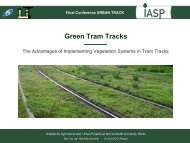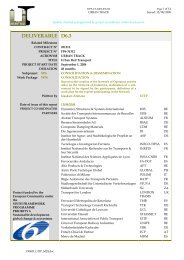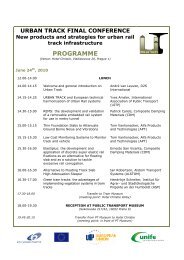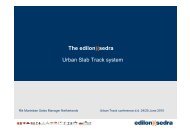DELIVERABLE 2.8 - urban track
DELIVERABLE 2.8 - urban track
DELIVERABLE 2.8 - urban track
You also want an ePaper? Increase the reach of your titles
YUMPU automatically turns print PDFs into web optimized ePapers that Google loves.
Figure 3.19<br />
D0208_STIB_M24.doc<br />
TIP5-CT-2006-031312 Page 41 of 44<br />
URBAN TRACK Issued: August 13, 2008<br />
Quality checked and approved by project co-ordinator André Van Leuven<br />
LCC Model: Results of the ATM – curve<br />
A few Viennese Curves were already implemented by the Österreichischen Bundesbahnen (Austrian<br />
railway, see capture …) and monitored over 6 years. It was found, that due the lower forces between<br />
wheel and <strong>track</strong> at the beginning and the end of the transition curve, fewer damages are estimated.<br />
Hence there was no maintenance necessary. In comparison with the conventional alignment, two times<br />
<strong>track</strong> packing with adjustment of the <strong>track</strong> level was necessary during this period. The result of the<br />
monitoring shows, that the ATM (Advanced Track Alignment) reduces cost through less maintenance<br />
work and longer lasting stability of the <strong>track</strong> structure. The additional expenses because of the advanced<br />
<strong>track</strong> alignment amortise quite shortly. Figure 3.20 shows the payback periods for the ATM-curve and<br />
the comparison of design expenses and maintenance savings. The cost savings by means of the ATM<br />
curve are demonstrated in figure 3.21. It is shown that the Viennese Curve is expected to produce cost<br />
savings of up to 12%.








